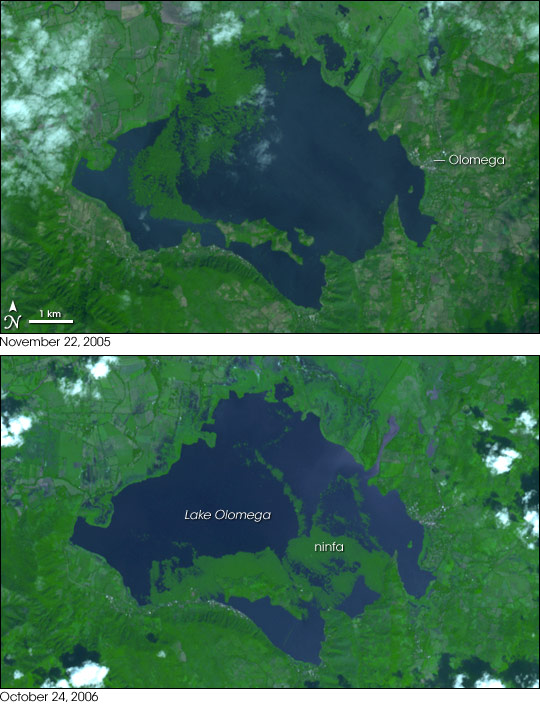


Water hyacinth, or Eichornia crassipes, ranks among the world’s most productive plants. Unfortunately, it has also proven to be one of the most troublesome. In 2006 in El Salvador’s Lake Olomega, where the aquatic plants are known locally as “ninfa” (the nymphs), they interfered with tourism, fishing, and even human health.
These images from the Advanced Spaceborne Thermal Emission and Reflection Radiometer (ASTER) on NASA’s Terra satellite show the wide-ranging extent and distribution of the aquatic plants on November 22, 2005 (top), and October 24, 2006 (bottom). In these simulated-true-color images, vegetation appears green, water appears blue, and bare ground and human structures appear pale blue-gray. In the bottom image, ninfa plants sprawl over a large area on the lake’s surface. These plants form enormous floating mats which shift in response to wind patterns, and can rapidly close off large portions of the lake to navigation.
Lake Olomega is a shallow lake of roughly 18 square kilometers (7 square miles) surface area, situated in southern El Salvador’s agricultural region. About 25 communities dot the lake’s shores, the largest—Olomega—with a population of approximately 4,000. The population around the lake is seasonal and depends heavily on tourism. As ninfa plants have interfered with navigation on the lake, they have hampered the area’s economy. At the same time, the plants have attracted grazing animals to the lake’s shores, polluting the water supply for nearby residents.
Besides navigation and pollution concerns, the ninfa plants have introduced another problem to the local population: arsenic. Ninfa plants absorb arsenic in the lake water into their own tissues, and the plants grow quickly, likely due to abundant fertilizers from surrounding farmland. Although humans don’s consume the plants directly, their livestock does, and the milk and meat from these animals can subsequently harm humans. Likewise, many nearby residents weave baskets from ninfa plants, selling many of the baskets to tourists.
Although the exact source of the arsenic in Lake Olomega is uncertain, it may result from geothermal systems, as it does in other Central American regions. Hot springs, especially in the southwestern portion of the lake, may introduce arsenic into the lake water. In 2006, Gregg Bluth and a student collaborator at Michigan Technological University found elevated arsenic levels in the lake and in a nearby hot spring. Bluth planned to use additional ASTER data to better understand the input of geothermal activity into Lake Olomega.
You can download a 15-meter-resolution Lake Olomega KMZ file for use with Google Earth.
NASA images created by Gregg Bluth and Matt Patrick at Michigan Technological University, using data provided courtesy of the NASA/GSFC/MITI/ERSDAC/JAROS, and U.S./Japan ASTER Science Team. Image interpretation by Gregg Bluth.